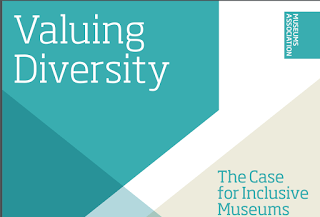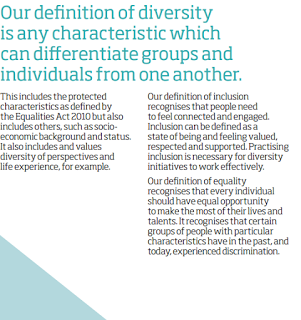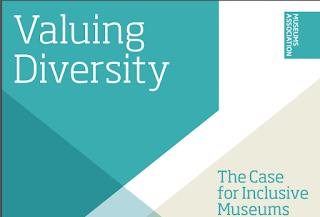Hi, Nicole here! As part of my work as a Mellon/ACLS fellow with CFM, I’m focusing on a constellation of issues related to museums and labor, including pathways to museum employment; wage equity in the sector; workforce practices promoting access and inclusion; and employee retention. A recent report of the UK Museums Association connects all of these issues in order to recommend some better practices that its member museums can use to reduce discrimination in the field. Although museums in the UK and the US operate in profoundly different political and economic landscapes—and with vastly different funding structures—I believe the Museums Association’s report has some important resonances with current discussions of diversity and inclusion in the US, including in AAM’s strategic plan. I urge you to take a look at the full report, share it with colleagues, and use it to guide your own thinking about diversity and inclusion in the field.
Last month, the UK Museums Association released a report examining the landscape of diversity, accessibility, equity, and inclusion in museums across the four nations of United Kingdom. Titled, “Valuing Diversity:The Case for Inclusive Museums,” the paper is part of the Transformers program, an initiative designed to promote innovative thinking among mid-career museum professionals. The piece is the product of a year-long research project exploring internal workforce dynamics. It features responses gathered from surveys of some 80 museum professionals about the state of inclusion in their individual institutions.
 |
| The Case for Inclusive Museums |
There is so much good thinking and persuasive reflection in the report. I especially appreciate how it places recruitment, day-to-day interactions, and audience engagement as part of a larger ecosystem of museum practice. It is tempting to focus our diversity efforts on outreach. But, this approach can reinforce an “us vs. them” binary. As Porchia Moore notes, diversity efforts that propose to bring so-called outsiders into museums can sometimes “send the message that museums are founded upon a dominant culture’s values” alone, without creating a framework for broadening authority in our institutions.
The “Valuing Diversity” report tackles this problem head-on. One of its key findings relates to the issue of power. The authors report that some of those surveyed “felt that more focus should be given to how power operates in organisations and how this impacts on policies and decision-making.” They rightly ask, “If the higher levels of our organizations are not diverse…then in what ways can we devolve decision-making to genuinely include and act upon diverse perspectives?” I read the word “devolve” here not in any pejorative sense, but as something more akin to the current use of disruption in discussions of organizational innovation. This focus on power is…well, powerful. It threads throughout the report as its authors consider the forces that produce inequity in the pipeline, in professional training programs, and in organizational structure. The report specifically engages the intersections of power and diversity by:
- Defining Diversity Broadly and Intentionally
- Identifying and Limiting Bias
Its authors make creative, ethical, and business cases for diversity while also stressing that “values-based change requires a commitment to understanding and embracing diversity fully, not simply to ensure that museums survive.”
Defining Diversity Broadly and Intentionally
 |
| Diversity, inclusion, equality defined in the report |
At first reading, the report’s definition of diversity can seem too vague. “Our definition of diversity,” the authors note, “is any characteristic which can differentiate groups and individuals from one another.” They then open up this fairly fuzzy definition to explain diversity as relational. “There are different understandings of what diversity means for each of the four nations [of the UK] and this requires acknowledgement,” the writers point out. The report highlights some specific contexts in which each of the UK’s four nations engage diversity. In Northern Ireland, the National Museums organization prioritizes “cohesive community relations.” In Wales, the organization Amgueddfa Cymru (National Museums Wales) has focused primarily on how museums can ameliorate poverty and respond to socio-economic diversity. Museums Galleries Scotland prioritizes valuing Scotland’s “own distinct indigenous practices alongside practices from other cultures.” For these groups, diversity is less a fixed label given to a specific cohort of people (e.g., “there’s the diversity over there!) than a relationship between people whose experiences, backgrounds, and abilities are different from one another.
The idea of diversity as a relationship that institutions can strengthen through intentional practice is underscored by a focus on unconscious bias. The authors explain that “unconscious bias not only impacts decisions related to recruitment and salary of individuals but also impacts investment in their ongoing development once inside an organization.” CFM founding director Elizabeth Merritt has piloted this work here at AAM and offers an honest, insightful recap of our recent challenge-based and non-traditional hiring practices.
Identifying and Limiting Bias
The report connects unconscious bias in the hiring process to its effects in the day-to-day workplace environment. “One clear piece of feedback we received,” the authors admit, “was that for people who self-identify…as being of a diverse background, the day-to-day experience of working in museums can be exhausting and can present regular emotional and psychological challenges.” These “micro-inequities,” as the report terms them, reflect unconscious (and sometimes conscious) forms of bias in institutions. These forms “communicate who is ‘within’ and who is ‘without.’”
By prioritizing inclusion practices across the spectrum of museum work, museums can create sustainable environments that ensure both engaged audiences and innovative institutions. These latter outcomes matter to museums abroad and at home.
Share your thoughts on the report with us on social media and in the comments section below!
Elizabeth Merritt












